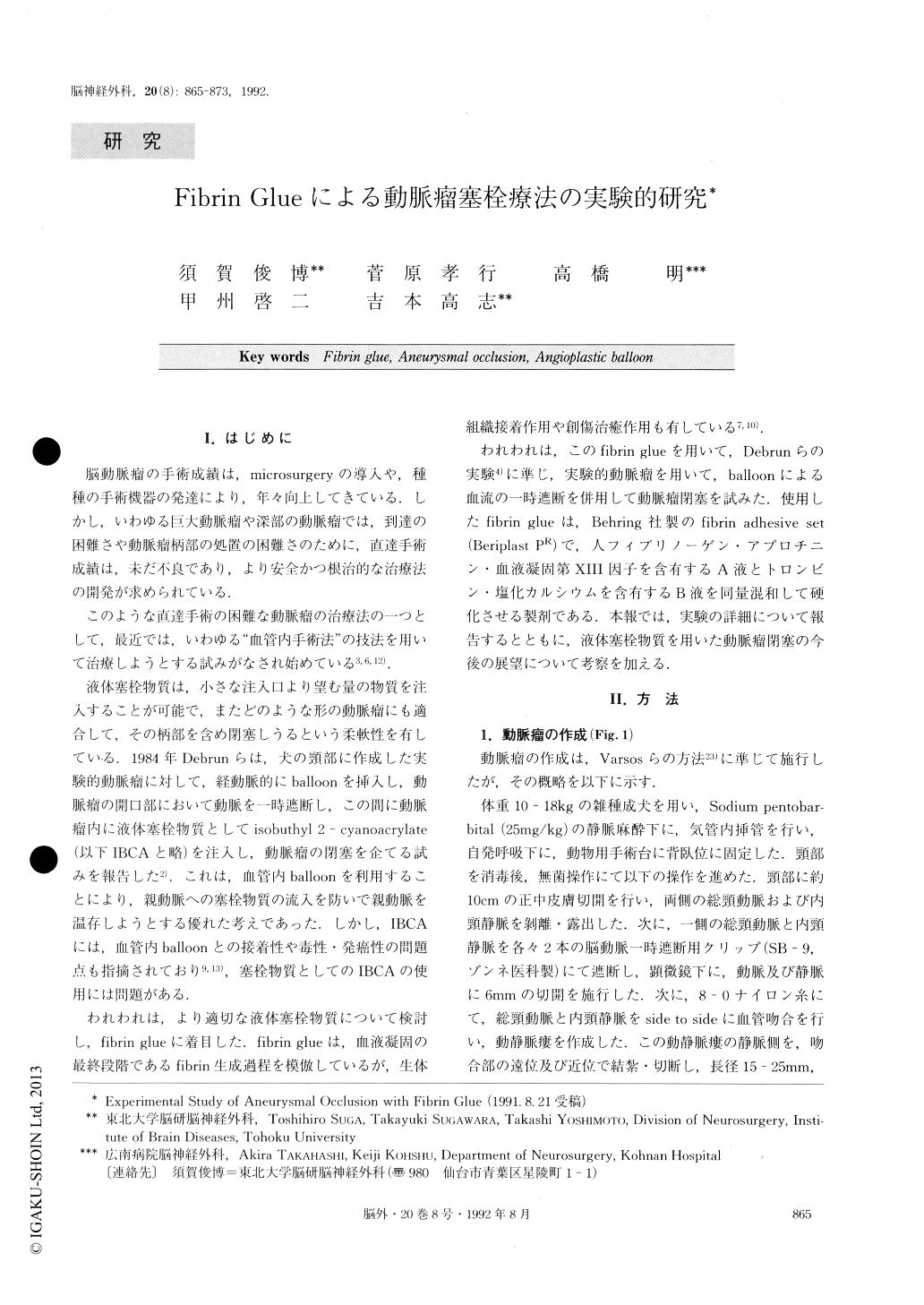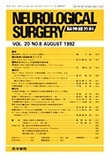Japanese
English
- 有料閲覧
- Abstract 文献概要
- 1ページ目 Look Inside
I.はじめに
脳動脈瘤の手術成績は,microsurgeryの導入や,種種の手術機器の発達により,年々向上してきている.しかし,いわゆる巨大動脈瘤や深部の動脈瘤では,到達の困難さや動脈瘤柄部の処置の困難さのために,直達手術成績は,未だ不良であり,より安全かつ根治的な治療法の開発が求められている.
このような直達手術の困難な動脈瘤の治療法の一つとして,最近では,いわゆる“血管内手術法”の技法を用いて治療しようとする試みがなされ始めている3,6,12).
液体塞栓物質は,小さな注入口より望む量の物質を注入することが可能で,またどのような形の動脈瘤にも適合して,その柄部を含め閉塞しうるという柔軟性を有している.1984年Debrunらは,犬の頸部に作成した実験的動脈瘤に対して,経動脈的にballoonを挿入し,動脈瘤の開口部において動脈を上一時遮断し,この間に動脈瘤内に液体塞栓物質としてisobuthyl 2—cyanoacrylate(以下IBCAと略)を注人し,動脈瘤の閉塞を企てる試みを報告した2).これは,血管内balloonを利用することにより,親動脈への塞栓物質の流入を防いで親動脈を温存しようとする優れた考えであった.しかし,IBCAには,血管内balloonとの接着性や毒性・発癌性の問題点も指摘されており9,13),塞栓物質としてのIBCAの使用には問題がある.
われわれは,より適切な液体塞栓物質について検討し,fibrin glueに着目した.fibrin glueは,血液凝固の最終段階であるfibrin生成過程を模倣しているが,生体組織接着作用や創傷治癒作用も有している7,10).われわれは,このfibrin glueを用いて,Debrunらの実験4)に準じ,実験的動脈瘤を用いて,balloonによる血流の一時遮断を併用して動脈瘤閉塞を試みた.使用したfibrin glueは,Behring社製のfibrin adhesive set(Beriplast P®)で,人フィブリノーゲン・アプロチニン・血液凝固第XIII因子を含有するA液とトロンビン・塩化カルシウムを含有するB液を同量混和して硬化させる製剤である.本報では,実験の詳細について報告するとともに,液体塞栓物質を用いた動脈瘤閉塞の今後の展望について考察を加える.
The authors report an experimental trial of intra-aneurysmal occlusion using fibrin glue.
Nowadays, with the development of microsurgical techniques and aneurysmal clips, results of direct radic-al operations have been improving. But quite a few aneurysms cannot be clipped because of their size, loca-tion, broad neck etc.
Some authors have treated these aneurysms with in-novative techniques (detachable balloon techniques etc).In these methods, the occlusive state of the aneurysms is not always obtainable because of the size of their neck. Besides, it is not always possible to preserve the parent arteries of the aneurysms.
Experimental aneurysms in cervical carotid arteries of dogs are treated by direct injection with fibrin glue. During its injection, influx of fibrin glue was prevented by occlusion of the aneurysmal orifices with inflated polyethylene angioplastic balloons.
The aneurysms which were completely (100%) filled by the injection of fibrin glue (100% infused group) were totally obliterated in 10 (71%) of the 14 cases. The parent arteries were completely preserved in all in-stances.
Follow-up study demonstrated satisfactory mainte-nance of this occluded state in the aneurysms in the 100% infused group. In completely occluded cases, all aneurysms maintained this state. On the other hand, 1 of the 4 incompletely obliterated aneurysms recanalized partially.
These occluded aneurysms were studied by a light microscope (LM) and a scanning electron microscope (SEM) . At day 7 after the occluding procedure, the margin of the aneurysmal orifice was covered by alayer of fibroblasts. At day 21, almost half of the aneurysmal cavity had been substituted with connective tissue. The orifice of the aneurysms was covered with an endothelial layer. At day 60, all aneurysmal space was replaced by connective tissue.
It is suggested that intra-aneurysmal occlusion using fibrin glue can be applied for the treatment of cerebral aneurysms, if the volume injected is sufficient.

Copyright © 1992, Igaku-Shoin Ltd. All rights reserved.


